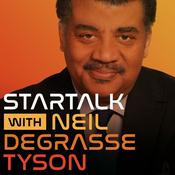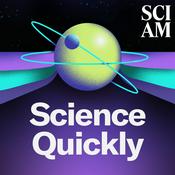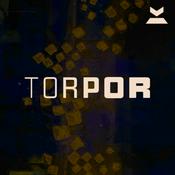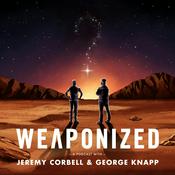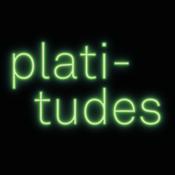36 episódios
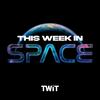
TWiS 192: Space, 2026! - What's Coming in Spaceflight This Year
09/1/2026 | 59min
2026 promises to be the most exciting year in the new space age yet! Shining bright is the prospect of an Artemis II launch to send astronauts around the moon for the first time since 1972, as early as February. We've already seen news about a medical incident on the International Space Station that will force a crew to return to Earth early, but NASA says this won't affect the Artemis launch. On other news, NASA's budget seems on track to be passed at near 2025 levels, China is preparing to send a robot to the south lunar pole, SpaceX plans robust tests of Starship this year—and hopefully refinement of their lander for Artemis III, Boeing will fly Starliner again (uncrewed), Mars Sample Return is poised to be scuttled, and all this under the leadership of a new—and apparently quite capable—NASA administrator, Jared Isaacman. Join us for an in-depth look at what's coming in 2026! Headlines: Medical evacuation planned for ISS astronauts due to health concerns NASA Chief Jared Isaacman leads first big press conference amid ISS medical incident Artemis 2 lunar mission remains on track for February launch Orion spacecraft heat shield faces scrutiny ahead of crewed flight NASA budget nearly secured—Congress backs full funding for 2026 Mars Sample Return project faces likely cancellation SpaceX Starship gears up for crucial orbital and refueling tests Blue Origin's Blue Moon lunar lander launch delayed, competition heats up China's lunar, asteroid, and orbital missions ramp up for 2026 Boeing Starliner and Sierra Space Dream Chaser schedule ISS cargo missions New moon landers, asteroid missions, and global crewed capsule tests coming in 2026 NASA's Roman Space Telescope possibly launching this year Hosts: Rod Pyle and Tariq Malik Download or subscribe to This Week in Space at https://twit.tv/shows/this-week-in-space. Join Club TWiT for Ad-Free Podcasts! Support what you love and get ad-free audio and video feeds, a members-only Discord, and exclusive content. Join today: https://twit.tv/clubtwit Sponsor: threatlocker.com/twit

TWiS 191: Mars Throwback - The Pioneering Work of Dr. Robert Zubrin
28/12/2025 | 53min
One of our favorite interviews of 2025 was with Dr. Robert Zubrin, founder of the Mars Society and the mind behind Mars Direct, a streamlined approach to reaching the Red Planet with human beings that was later largely adopted by NASA in their mission designs. It's a fascinating story about a man who continually swam upstream against strong currents of the aerospace establishment. His seminal book, "The Case for Mars," has enjoyed multiple reprints and influenced millions. Join us for this encore of an informative and forward-looking episode! Hosts: Rod Pyle and Tariq Malik Download or subscribe to This Week in Space at https://twit.tv/shows/this-week-in-space. Join Club TWiT for Ad-Free Podcasts! Support what you love and get ad-free audio and video feeds, a members-only Discord, and exclusive content. Join today: https://twit.tv/clubtwit

TWiS 190: Holiday Special 2025 - A Look Back at 2025 in Space!
19/12/2025 | 1h 3min
It's our annual holiday special for 2025, in which we look back at the past year in space—its ups, its downs, its all-arounds. What a year it's been, and after all the challenges and hullabaloo, we're grateful in a post-Thanksgiving fashion to welcome Jared Isaacman, at last, as the new NASA Administrator. What he will do and how remains largely unknown, but we do believe he has the nation's interests at heart, and the man knows people are watching. But there are a lot of other stories and we've done our best to stuff as many as we can into this virtual Christmas space stocking! Please join us for this year-end roundup! Headlines & Looking Back at 2025: New Executive Order Targets Space Superiority Starlink Satellite Breaks Up in Orbit, SpaceX Responds Interstellar Comet ATLAS: Extraterrestrial Conspiracies and Public Fascination Isaacman Confirmed as New NASA Administrator Project Athena: NASA's New Strategic Direction? Artemis 2 Mission Prep and Timeline Shifts Mars Sample Return: Uncertain Costs and New Proposals Commercial Spaceflight: SpaceX Successes, Boeing Troubles Perseverance Rover Finds Possible Mars Biosignatures Recap Space Shuttle Discovery Relocation Battle Heats Up New Moon Discovered Around Uranus Webb Telescope and Hubble Milestones International Space Station Celebrates 25 Years of Crewed Work U.S. Space Policy Shifts and NASA's New Leadership Satellite Operations: Starlink's Reliability and Space Junk Concerns Hosts: Rod Pyle and Tariq Malik Download or subscribe to This Week in Space at https://twit.tv/shows/this-week-in-space. Join Club TWiT for Ad-Free Podcasts! Support what you love and get ad-free audio and video feeds, a members-only Discord, and exclusive content. Join today: https://twit.tv/clubtwit

TWiS 189: Privatizing Orbit - The Pioneering Work of Jeffrey Manber
12/12/2025 | 1h 13min
This week, we talk with our favorite Newspace Buccaneer, Jeffrey Manber. When so many people were touting their private spaceflight dreams in the 1980s, Manber took the next enormous stride and actually made it happen. He formed the Office of Space Commerce within the US Department of Commerce at the invitation of the Reagan administration, forged the first commercial relations with the then-Soviet Union, bridged that into the post-USSR period, and was responsible for the first commercial spaceflight to the then-mothballed Soviet-era Mir space station with a crew that stayed there for 70 days. He then went on to develop a variety of commercial space enterprises, from the first commercial platform to release smallsats from the ISS to initiating the Bishop airlock that became part of the space station. He also started Nanoracks, the first privately developed and standardized satellite deployment mechanism to fly. Finally, he initiated Starlab, the private space station currently under development by Voyager Technologies and a consortium of aerospace companies. Join us for this very special episode with one of the key founders of NewSpace! Headlines: SpaceX Plans 2026 IPO and Possible $1.5 Trillion Valuation NASA Loses Contact with Mars Maven Orbiter Discussion of Star Trek's New Starfleet Academy Series Trailer Main Topic: Privatizing Orbit and the Roots of Commercial Space Jeffrey Manber Details His Early US-Russian Commercial Space Collaborations His Space Journalism Origins and Shaping Commercial Space Policies Inside the Launch of Commercial Space Fund and the Office of Space Commerce First US Commercial Contracts with the Soviet Union and Mir Space Station Navigating Washington Policy and Export Licenses for Soviet Deals Attempt to Privatize Mir: Mirkorp, Leasing the Space Station, and Commercial Astronaut Crews The Rise of Nanoracks and Commercial Payloads on the ISS Building Starlab: Partnerships, Scale, Launch Plans, and Commercial Design Comparing Starlab's Ambitions to Vast, Axiom, and China's Tiangong Evaluating SpaceX's Public Offering and Its Impact on Elon Musk's Strategy Jeffrey Manber's Other Projects: Writing About Newspace and President Lincoln Thoughts on America's Future in Commercial Orbit and Personal Memoir Plans Hosts: Rod Pyle and Tariq Malik Guest: Jeffrey Manber Download or subscribe to This Week in Space at https://twit.tv/shows/this-week-in-space. Join Club TWiT for Ad-Free Podcasts! Support what you love and get ad-free audio and video feeds, a members-only Discord, and exclusive content. Join today: https://twit.tv/clubtwit

TWiS 188: A New NASA Leader Rises? - Trump's NASA Chief Pick Jared Isaacman Meets Congress Again
05/12/2025 | 58min
Jared Isaacman, the billionaire entrepreneur, philanthropist, and private astronaut, took on Capitol Hill this week in his second confirmation hearing as President Trump's pick for NASA's next leader. Here's what it could mean, plus: A Russian cosmonaut got kicked off a SpaceX flight for allegedly trying to steal spacecraft secrets, China's 1st reusable rocket Zhuque-3 reached orbit, but crashed and burned (and exploded) during landing, and Russia accidentally wrecked the only launch pad it has for astronauts with Thanksgiving's new ISS crew launch. Headlines: Russian Cosmonaut Pulled from SpaceX Crew 12 Mission over Alleged Incident at SpaceX HQ Russian Soyuz Launch Pad Damaged After Thanksgiving Crew Mission, Threatening Future Flights China's Land Space Rocket Nearly Sticks First Reusable Launch and Landing—Explodes on Return Scientists Find Time Passes Faster on Mars Than Earth, Thanks to Relativity Main Topic: Jared Isaacman's Bid to Become NASA Administrator Isaacman Returns for Second Senate Confirmation Hearing After Trump Re-Nominates Him Controversy Over SpaceX Ties, Conflict of Interest, and Elon Musk's Influence Bipartisan Support from Astronauts, Industry, and Lawmakers Highlights Isaacman's Appeal Project Athena Leaked: Isaacman's Vision for NASA and Debate on Earth Science Outsourcing Congressional Drama Over Artemis Funding, Gateway, and the US-China Race to the Moon Questions Around Space Shuttle Discovery's Possible Move to Houston Anticipation Builds for Senate Vote and NASA's Need for Stable Leadership Ahead of Artemis 2 Host: Tariq Malik Guest: Mike Wall Download or subscribe to This Week in Space at https://twit.tv/shows/this-week-in-space. Join Club TWiT for Ad-Free Podcasts! Support what you love and get ad-free shows, a members-only Discord, and behind-the-scenes access. Join today: https://twit.tv/clubtwit
Mais podcasts de Ciência
Podcasts em tendência em Ciência
Sobre This Week in Space (Audio)
Ouça This Week in Space (Audio), Ta de Clinicagem e muitos outros podcasts de todo o mundo com o aplicativo o radio.net

Obtenha o aplicativo gratuito radio.net
- Guardar rádios e podcasts favoritos
- Transmissão via Wi-Fi ou Bluetooth
- Carplay & Android Audo compatìvel
- E ainda mais funções
Obtenha o aplicativo gratuito radio.net
- Guardar rádios e podcasts favoritos
- Transmissão via Wi-Fi ou Bluetooth
- Carplay & Android Audo compatìvel
- E ainda mais funções


This Week in Space (Audio)
baixe o aplicativo,
ouça.





